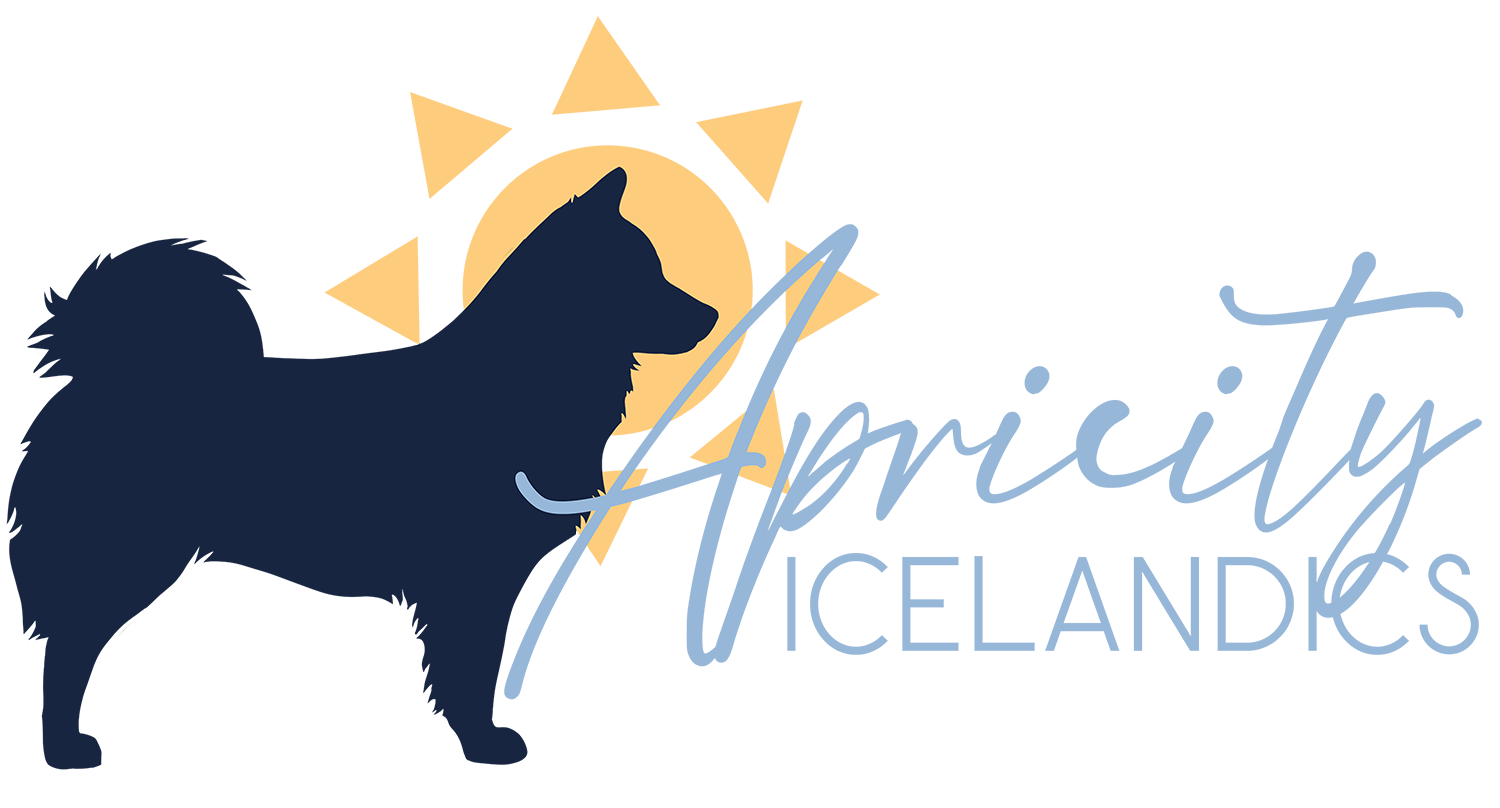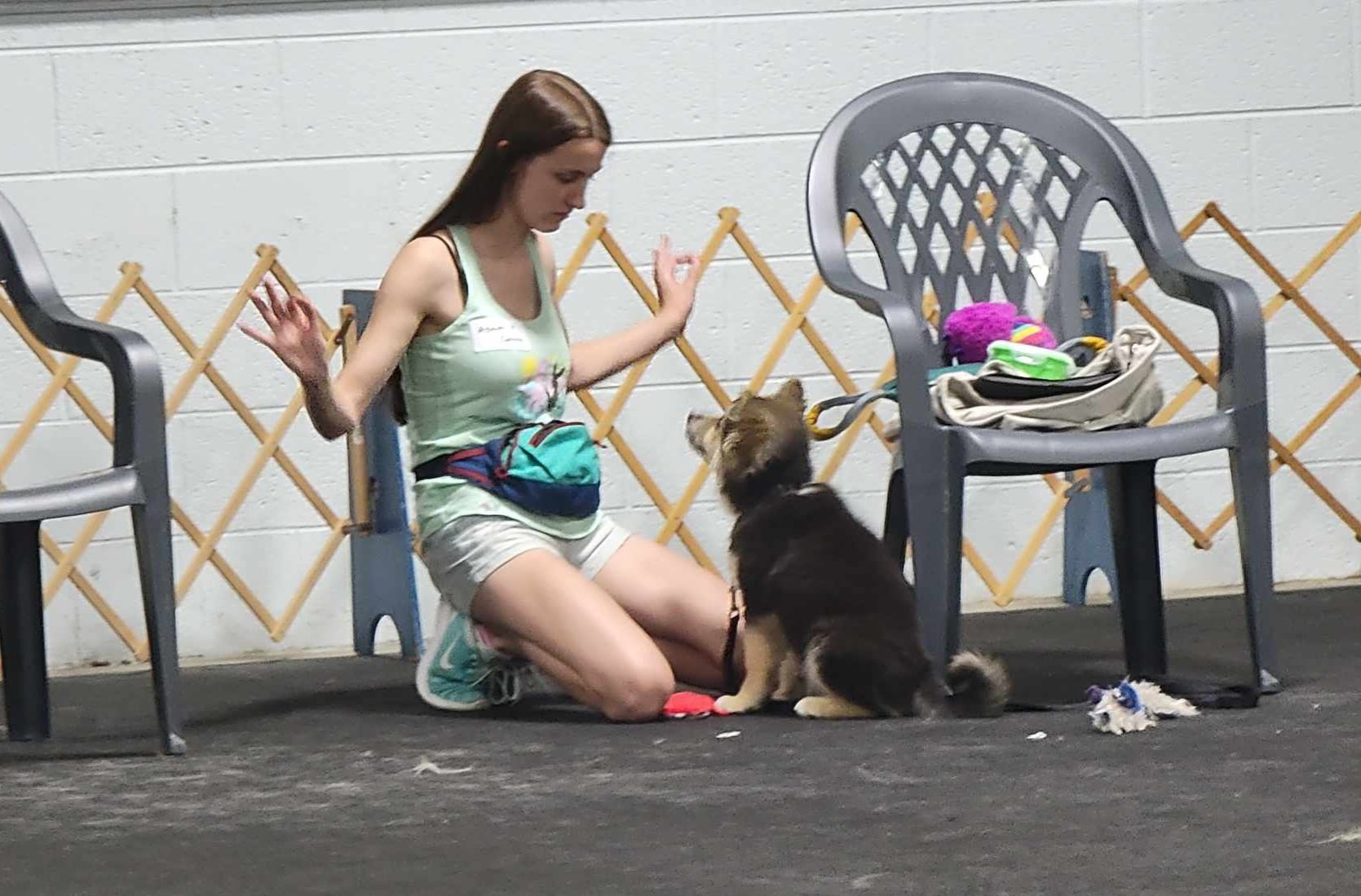Laying a Solid Foundation
Now that we have discussed bonding with your puppy and watching for signs of fear periods, it’s time to touch on foundation behaviors! Like other areas in life, the foundations of puppy training are what holds you up when things get tough, what you fall back on when it seems like things aren’t going the way you’d hoped, and the base layer for something wonderful that you can continue to build on. My goal for this post is to discuss some foundation behaviors that have been very successful for me when training my own Icelandic Sheepdogs, but this is unlikely to be a comprehensive list.
The single most important initial behavior to work on with your new puppy is recall. Coming when called saves lives, and a trustworthy recall is incredibly valuable when branching out with your dog into exploration and off leash freedom, which most absolutely thrive on. I begin working recall before puppies I have produced leave my house, but it is very important to continue this process. The first rule of recall is to ALWAYS, ALWAYS, ALWAYS reward your puppy, and even your adult dog, for coming when called. I also reward voluntary check-ins. Have treats on you at all times so you can appropriately reward this crucial behavior. As your puppy ages, you may need to increase the value of the reward and you can use long lines and distractions to elevate your training. Young puppies often naturally want to stick close, so be sure to encourage this natural behavior and reward it often to help it remain.
After recall, the second behavior I encourage in my young puppies is eye contact. Rewarding eye contact encourages your dog to learn to look to you for answers. In puppies, I will start teaching this behavior just by saying their name and drawing a treat from my eyes down to offer to them. I will then introduce distractions like placing a treat under my foot and waiting for them to look up at my face, marking the behavior with a “yes” or clicker, and then allowing them to take the treat. This type of implied permission helps with impulse control and encourages your puppy to look at you, ignoring what they may want, and then giving you the opportunity to either grant them permission to access it or encourage an alternate behavior. This will translate well down the road to reduce unwanted behaviors like barking and lunging on leash; as you move out into areas of distraction, continue to reward all voluntary and requested eye contact so your puppy continues to pay attention to you and look to you for information about what to do next. When this behavior is heavily rewarded as the puppy grows, that reinforcement history will help encourage your dog to automatically look to you when encountering new and exciting things, rather than taking matters into their own hands (paws?).
One of the biggest complaints from Icelandic Sheepdog owners is how much they bark. Barking is part genetics and part training. One of the key components to reduce barking, is actually to start managing it before it occurs. Icelandic Sheepdog puppies bark some, but barking and reactivity really do not ramp up until around 6 months of age and into adolescence. We can reduce and mitigate barking by rewarding young puppies constantly for their choice NOT to bark but instead quietly observing the world around them. If you are new to Icelandic Sheepdogs, this does require a bit of creativity and careful consideration. It can be difficult to remember to reward something you didn’t actually ask for, but it is incredibly valuable in this breed to encourage making correct choices. It also continues to build the bond with your puppy by giving food and treats for something “easy”. When you are at home and something happens that catches your puppy's attention – the cat runs by, a car drives up, someone knocks on the door, the neighbor’s dog starts barking, etc. – STOP immediately and reward your puppy for being alert to what just occurred and being quiet about it. When something startles a young puppy, they will often note the occurrence and be still to observe it, which is exactly when you want to catch them. I say “GOOD QUIET” and give the puppy a yummy treat. This again encourages your puppy to look to you for encouragement about how to respond to a scenario and rewards them for making the correct choice. When you are out and about with your young puppy, be sure to do something similar – bicycles, skateboards, cars passing by, people and dogs, etc. – reward your puppy often and excitedly for choosing to observe without reacting. If your puppy naturally looks to you seeking eye contact, again make sure you mark and reward this behavior!
As your puppy gets a bit older, usually around 3-5 months, they are more likely to start barking when something startles them or at moving objects and strange dogs. Ideally, you note the THING they are going to bark at and catch them before it happens – I will say “good quiet” which they already know from the training discussed above and start offering treats. If needed we will also move backward away from the stimulus which encourages the puppy to look at and follow me. The end goal being that when presented with something they consider barking at, your puppy instead looks to you for information. If you both are startled and you are unable to catch them before the barking starts, I highly recommend interrupting any type of reactive barking, especially when walking on leash. This behavior tends to escalate quickly and will turn into a lunging and “reactive” adolescent faster than you expect. Some trainers and owners may decide to try to wait out the barking until the dog makes the correct choice; in my experience with this breed, this is not very effective. Barking is very rewarding for Icelandic Sheepdogs and if you decide to wait it out, they will nearly always elect to bark rather than stop without some sort of interruption from you. If your young puppy starts barking, I first start by saying their name and seeking eye contact, which often encourages them to stop and look to me. I then use basic commands to instruct them on correct behavior and give them something to do to discourage barking and staring/reacting. In other words, I keep their brains busy and their mouth full of treats. I interrupt the bark and then reward eye contact and then we walk the other way, do spins, tug a toy, do sit/down/chase a treat, anything to show them that engaging with me instead of barking is extremely valuable and FUN.
Many Spitz breeds have some difficulty with handling and restraint – especially for procedures they may dislike like nail trims, blood draws, vaccines, etc. Some Icelandic Sheepdogs will be very resistant to any type of restraint handling, so I highly recommend practicing these types of behaviors and cooperative care techniques in puppyhood. This encourages your puppy to respond positively to being made to hold still, rather than fighting and becoming stressed when handled. Practice looking at the teeth, the ears, handling the feet, holding them against your chest like a veterinary technician, and picking up and admiring each individual toe/toenail. A lot of puppies also dislike their head or muzzle being held, so I also recommend working on this at home. For all of these behaviors you will want to start very small and then build up to higher levels of restraint. Always give lots of treats and praise for your puppy accepting handling with a relaxed demeanor and use a release word to tell them when they are finished, like “okay” or “all done”. Practicing these behaviors when puppies are young will help reduce stress for both of you when heading to the veterinary clinic with an adult Icelandic Sheepdog. If you’re unsure what restraint may look like, please discuss with your veterinarian at puppy vaccine appointments and ask about behaviors and techniques that you can practice at home.
Crate training, in my opinion, is a vital skill for any puppy or adult dog of any breed. And it is, indeed, a skill – if we do not continue to practice it consistently, it will be lost. All puppies I produce are started on crate training before they leave my house. They are used to being crated overnight and for at least part of the work-day as I try to adjust them to a schedule for a family who works outside the home. They are crated alone and accustomed to being separated from their littermates. I highly encourage you to maintain this vital skill. Continue to crate your puppy through the night and for at least part of the day, every day. Make sure you practice crate time when you are home, as well as when you are out of the house. We do not want your puppy to associate the crate with you always leaving home, which can sometimes cause them to throw tantrums if you need to utilize the crate when you are nearby or just in the next room. Crating is also a great way to separate dogs for meal times, give your puppy quiet time to nap or enjoy a high value treat or chew, and provides a safe space for them when unattended. When crating, make sure that you continue to be very consistent on not releasing your puppy from the crate unless they are quiet. If you start to release them for barking or pawing at the crate, they will believe this behavior triggers the crate to open. All puppies and adults should be released from the crate only when quiet or calm, unless it is clear they are about to have a bathroom emergency!
The foundation skills you teach your puppy are vital for encouraging them to grow into an adult dog you enjoy. The most important part of raising your puppy is to remember to be proactive. Puppies are sponges for new information. They are open to whatever you hope to teach them, and being cognizant of how intelligent they are really is essential for tapping into their potential. Always reward what you like when your puppy offers appropriate behaviors, and try to expose your puppy to scenarios that you are likely to encounter with your adult dog. If you want a dog that enjoys camping and hiking, a dog who enjoys sports and training classes, or a dog who is home alone often – be sure to practice those scenarios as a young puppy to help set you both up for success in the future. Never underestimate the power of reinforcement history to help mold your new puppy and encourage beneficial behaviors.






